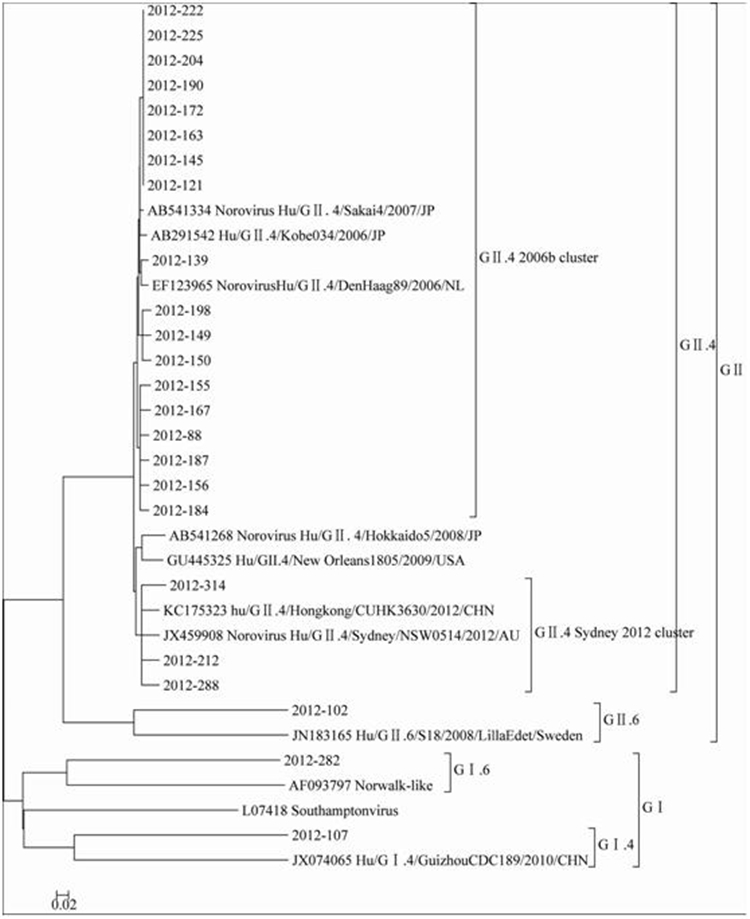诺如病毒(Norovirus,NoVs)是引起急性胃肠炎的主要病原之一,超过90%的非细菌性腹泻以及全球约有50%的腹泻与诺如病原相关[1] [2]。诺如病毒属于杯状病毒科,单链小RNA病毒,可分为5个基因组(G I~G V), G I和GⅡ基因组与人群中大部分急性胃肠炎相关[3]。根据诺如病毒VP1基因S区,将G I和GⅡ基因组分别分为14和17个基因型,其中GⅡ.4变异快,GⅡ.4基因型每2~3年出现新的变异株,导致约60%~80%的急性胃肠炎疫情暴发流行[4]。2012年底,多个国家和地区报道发现GⅡ.4 Sydney变异株,导致当地胃肠炎疫情暴发[5][6][7]。GⅡ.4 Sydney变异株在广西壮族自治区(广西)是否流行,尚未报道。为了解广西诺如病毒基因型谱以及GⅡ.4 Sydney变异株的流行情况,2012年在广西罗城县监测点开展诺如病毒监测,结果报告如下。
1 材料与方法1.1 研究对象
2012年1-12月在罗城县对5岁以下急性腹泻住院婴幼儿进行监测并收集粪便标本,标本收集对象要求每日排便3次或3次以上,且大便形状有改变(呈稀便、水样便),大便常规镜检WBC<15,未见RBC的腹泻病例,或病例表现为腹泻未达到3次/日,但伴有大便性状改变和呕吐症状,或以呕吐为主要症状。收集病例粪便标本,采集后置-20 ℃冻存。
1.2 标本处理取约0.1 g固体粪便或0.1 ml液体粪便标本至1.5 ml Epppendorf 管中,加入0.9 ml 粪便稀释液,制备10%粪便悬液,剧烈振荡后8000 r/min离心5 min,吸取上清备用。
1.3 RNA提取和诺如病毒反转录-聚合酶链反应(reverse transcription-polymerase chain reaction,RT-PCR)鉴定以磁珠法提取病毒RNA,50 μl EB洗脱。RNA提取试剂盒购置AB公司。提取的RNA以六碱基随机引物(TaKaRa,0.2 μg/μl)进行反转录,待检标本RNA 11 μl,随机引物(0.2 μg/μl)1 μl,混匀,短暂离心,95 ℃变性5 min,立即冰浴;短暂离心后在反应管中加入其他反应物,合成病毒cDNA文库,反应条件参考试剂盒说明书(Invitrogen公司)。使用PCR方法扩增诺如病毒VP1区部分核苷酸,引物参考文献[8],引物由上海生工生物技术服务有限公司合成(HPLC级),DNA聚合酶购自Promega公司。
1.4 核酸序列测定和分析PCR产物387 bp,送北京博迈德公司进行序列测定。用于序列进化分析的参考株来自NCBI的GenBank,使用clustalX1.8 和Mega 4.0 进行序列比对和同源性分析, 并用邻近归并法(Neighbor-joining, NJ)构建核苷酸系统进化树。
2 结果2.1 检测结果
2012年罗城县共收集5岁以下腹泻患儿粪便标本323份,检出诺如病毒核酸阳性标本24份,阳性检出率为7.43%。
2.2 基因分型和序列分析序列测定获得24份诺如病毒VP1区部分核苷酸序列,通过诺如病毒自动分型软件分析(http://www.rivm.nl/mpf/norovirus/typingtool/)[9],属于4种不同基因型,其中诺如病毒GⅠ基因组2份(8.33%),GⅠ.4和 GⅠ.6各1份;诺如病毒GⅡ基因组22份(91.67%),GⅡ.4基因型21份(95.45%),GⅡ.6基因型1份(4.55%)。在GⅡ.4基因型中,21份核苷酸序列一致性为95.7%~100.0%,在系统进化树中分为2簇(图1),18份(85.71%)与GⅡ.4 2006b变异株在进化树的同一簇,与参考株AB291542核苷酸一致性为98.3%~98.9%,另3份(14.29%)与GⅡ.4 Sydney变异株(JX459908)的同源性为98.9%~100.0%,在同一分支上。没有检测到GⅡ.4 New Orleans 变异株。
图1 诺如病毒VP1区部分核苷酸序列系统进化树Figure 1 Phylogenetic analyses of partial VP1 region of detected norovirus genomes 2.3 时间分布
2012年1 8月收集的病例标本中检出诺如病毒2份(2/105),9 11月收集的标本诺如病毒检出率升高,其中10月检出率最高,为18.64%(11/59);11月和12月在3例病例标本中检测到GⅡ.4 Sydney变异株,见表1。
表1 2012年广西罗城县诺如病毒基因分型时间分布Table 1 Monthly distribution of samples with different genotypes detected,2012
| 月份 | 病例数 | 诺如病毒基因型 | |||||
| 检测 | 诺如病毒阳性 | GⅠ | GⅡ4.Sydney cluster | GⅡ4.2006b cluster | GⅡ.6 | ||
| 1-8 | 105 | 2 | 0 | 0 | 1 | 1 | |
| 9 | 29 | 3 | 1 | 0 | 2 | 0 | |
| 10 | 59 | 11 | 0 | 0 | 11 | 0 | |
| 11 | 93 | 6 | 0 | 2 | 4 | 0 | |
| 12 | 37 | 2 | 1 | 1 | 0 | 0 | |
| 合计 | 323 | 24 | 2 | 3 | 18 | 1 | |
诺如病毒是一组具有高度遗传多样性的单链RNA病毒,在人群中流行的基因组主要有GⅠ基因组的14种基因亚型和GⅡ基因组的17种基因亚型,其中GⅡ.4基因型因具有与流感病毒相似的高效传播和快速变异的特点,自1995年以来,至少出现4次新旧变异株的更替(1995年的US95/96株、2002年的Farmingtong Hills株、2004年Hunter株、2006年2006 a/b变异株)而导致全球急性胃肠炎疫情流行[10]。2012年底,在澳大利亚、美国等先后报道诺如病毒急性胃肠炎疫情暴发,并在病例标本中发现新的GⅡ.4 Sydney变异株[5][6][7]。近几年,诺如病毒GⅡ.4 2006b变异株一直是我国散发和暴发急性胃肠炎的病原流行优势株[11][12],但在2012年底至2013年初,我国北京、香港、广州、江苏省等地区均报告GⅡ.4 Sydney变异株的流行[13][14][15][16],国内其他地区是否出现该变异株,尚未有相应报道。广西罗城县腹泻监测点建立于2006年,当地诺如病毒的流行特点与其他地方相似,以2006b变异株为主要流行株[17]。在2012年度的监测中,检测到GⅠ.4、GⅠ.6、GⅡ.4和GⅠ.6共4种基因型,与2007 2008年度罗城县单一GⅡ.4流行基因型比较,罗城县诺如病毒流行基因型呈现多样性,但仍以GⅡ.4 为主要流行基因型,2006b变异株为主要流行株,同时在11月和12月的3例散发病例中检测出GⅡ.4 Sydney变异株,这是在广西首次发现诺如病毒 GⅡ.4 Sydney变异株。2012年诺如病毒检出率为7.43%,尤其是11月和12月诺如病毒检出率,与2007 2011年同期相比,没有明显升高(数据未列出),提示广西罗城县虽然在散发病例中发现新的GⅡ.4 Sydney变异株,但尚未出现诺如病毒急性胃肠炎暴发流行。由于本监测仅在罗城县开展监测以及监测病例有限,GⅡ.4 Sydney变异株在广西境内的流行特点仍需进一步研究。鉴于GⅡ.4 Sydney变异株在丹麦等地首先在散发病例中发现,后引起疫情暴发的流行特征[18],需警惕广西地区诺如病毒GⅡ.4 Sydney变异株代替2006b变异株,引起急性胃肠炎的暴发流行。
[2] Fischer WC, Sack D, Black RE. Etiology of diarrhea in older children, adolescents and adults: a systematic review[J]. PLoS Negl Trop Dis, 2010,4:e768.
[3] Bok K, GreenKY.Norovirus gastroenteritis in immunocompromised patients[J]. N Engl J Med, 2012,367: 2126-2132.
[4] Yang Y, Xia M, Tan M,et al. Genetic and phenotypic characterization of GⅡ-4 noroviruses that circulated during 1987 to 2008[J]. J Virol, 2010,84:9595-9607.
[5] Van Beek J, AmbertBalay K, Botteldoorn N, et al. Indications for worldwide increased norovirus activity associated with emergence of a new variant of genotype Ⅱ 4, late 2012[J]. Euro Surveill, 2013,18(1):20345
[6] Leslie Barclay, Mary Wikswo, Nicole Gregoricus, et al. Emergence of New Norovirus Strain GⅡ 4 SydneyUnited States,2012[J]. Morb Mortal Wkly Rep, 2013,62(3):55.
[7] Bennett S, Maclean A, Miller R,et al. Increased norovirus activity in Scotland in 2012 is associated with the emergence of a new norovirus GⅡ 4 variant[J]. Euro Surveill, 2013,18(2):20349
[8] Liu LJ,Liu W,Liu YX,et al.Identification of norovirus as the top enteric viruses detected in adult cases with acute gastroenteritis[J]. Am J Trop Med Hyg, 2010,82(4):717-722.
[9] Kroneman A, Vennema H, Deforche K, et al.An automated genotyping tool for enteroviruses and noroviruses[J]. Clin Virol, 2001,1:121-125.
[10] Bull RA, White PA. Mechanisms of GⅡ 4 norovirus evolution[J]. TrendsMicrobiol, 2011,19:233-240.
[11] Gao Y, Jin M, Cong X, et al. Clinical and Molecularepidemiologic analyses of norovirusassociated sporadic gastroenteritis in adultsfrom Beijing, China[J]. J Med Virol,2011,83:1078-1085.
[12] Zeng M, Xu X, Zhu C, et al. Clinical and molecularepidemiology of norovirusinfection in childhood diarrhea in China[J]. J Med Virol, 2012,84:145-151.
[13] Huan Mai1, Miao Jin,XiaoLin Guo.Clinical and Epidemiologic Characteristics of Norovirus GⅡ 4 Sydney during Winter 2012-13 in Beijing, Chinafollowing Its Global Emergence[J]. PLoS One, 2013,8(8):e71483.
[14] Chan MC, Chan PK. Complete genome sequence of a novel recombinant human norovirus genogroup II genotype 4 strain associated with an epidemic during summer of 2012 in HongKong [J] .Genome Announcements, 2013,1(1): e00140-12.
[15] Cai WF, Xie HP, Liu YF,et al. An epidemiological investigation on a foodborn outbreak of Norovirus caused by Sydney 2012 G II 4[J]. Chinese Journal of Epidemiology, 2013,34(8):804-807.(in Chinese)蔡文锋,谢华萍,刘于飞,等. 一起食源性诺如病毒G Ⅱ 4/Sydney-2012变异株感染暴发调查[J]. 中华流行病学杂志,2013,34(8):804-807.
[16] Fu JG, Ai J, Jin M, et al. Molecular characteristics of acute gastrocenteritis outbreak caused by norovirus, in Jiangsu province[J]. Chinese Journal of Epidemiology, 2013,34(8):808-811.(in Chinese)
付建光,艾静,靳淼,等. 江苏省近期急性胃肠炎暴发中诺如病毒分子特征分析[J]. 中华流行病学杂志,2013,34(8):808-811.
[17] Chen MM, Zhou KJ, Mo ZJ, et al.Molecular epidemiology of human caliciviruse infectious in Guangxi,2007-2008[J]. China Tropical Medicine, 2010,10(8):941-943.(in Chinese)
陈敏玫,周开姣,莫兆军,等 2007—2008 年广西监测点婴幼儿人杯状病毒腹泻监测分析[J].中国热带医学,2010,10(8):941-943.
[18] Fonager J, Hindbaek LS, Fischer TK.Rapid emergence and antigenicdiversification of the norovirus 2012 Sydney variant in Denmark, October to December,2012[J]. Euro Surveill, 2013,18(9):pii=20413.
|
扩展功能
|
|
| 本文信息 | |
| PDF全文 | |
| HTML全文 | |
| 参考文献 | |
| 服务与反馈 | |
| 加入引用管理器 | |
| 引用本文 | |
| Email Alert | |
| 本文作者相关文章 | |
| 陈敏玫 | |
| 周开姣 | |
| 居昱 | |
| 谭毅 | |
| PubMed | |
| Article by CHEN Min-mei | |
| Article by ZHOU Kai-jiao | |
| Article by JU Yu | |
| Article by TANG Yi | |
